Trace Element Geochemistry of Chalcopyrites and Pyrites from Golpu and Nambonga North Porphyry Cu-Au Deposits, Wafi-Golpu Mineral District, Papua New Guinea
Abstract
:1. Introduction
2. Geological Setting
2.1. Stratigraphy
2.2. Structures
2.3. Intrusions of the Golpu and Nambonga North Porphyry Centres
2.4. Other Intrusive Suites
2.5. Alteration and Mineralisation
3. Trace Element Geochemistry of Pyrite and Chalcopyrite
3.1. Sampling Method and Analytical Procedures
3.2. Analytical Results
4. Discussion
4.1. Implications of the Trace Element Composition of Pyrite
4.2. Implications of Trace Element Composition of Chalcopyrite
4.3. Porphyry-Related Alteration and Mineralisation
4.3.1. Potassic Alteration
4.3.2. Propylitic Alteration
4.3.3. Chlorite-Sericite Alteration
4.3.4. Phyllic Alteration
4.3.5. Relation of the Wafi High Sulphidation Au Deposits to the Golpu Porphyry Cu-Au System
5. Conclusions
Author Contributions
Funding
Data Availability Statement
Conflicts of Interest
Appendix A. LA-ICPMS Results from the Pyrite Samples from the Golpu and Nambonga North Porphyry Deposits, WGMD, PNG

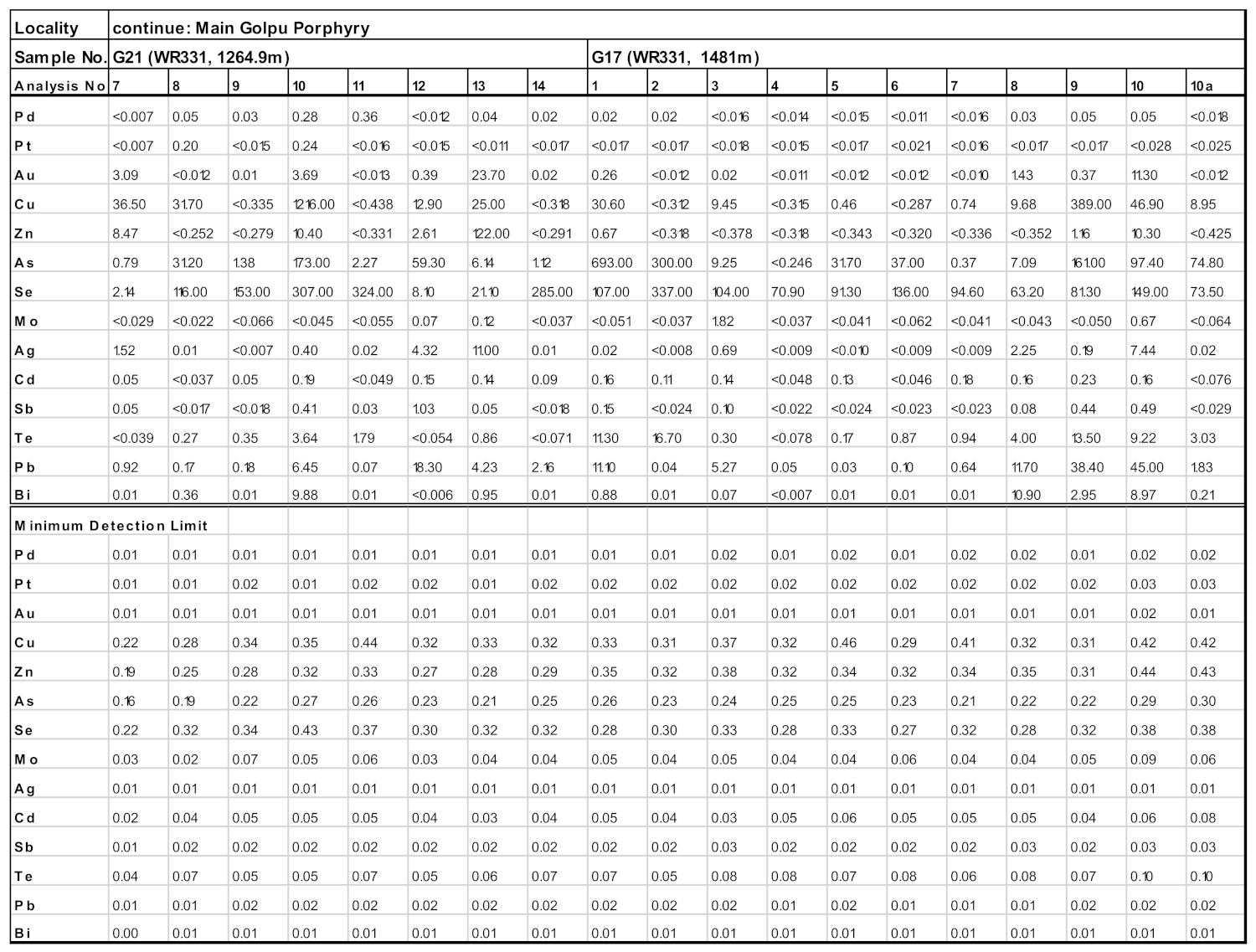

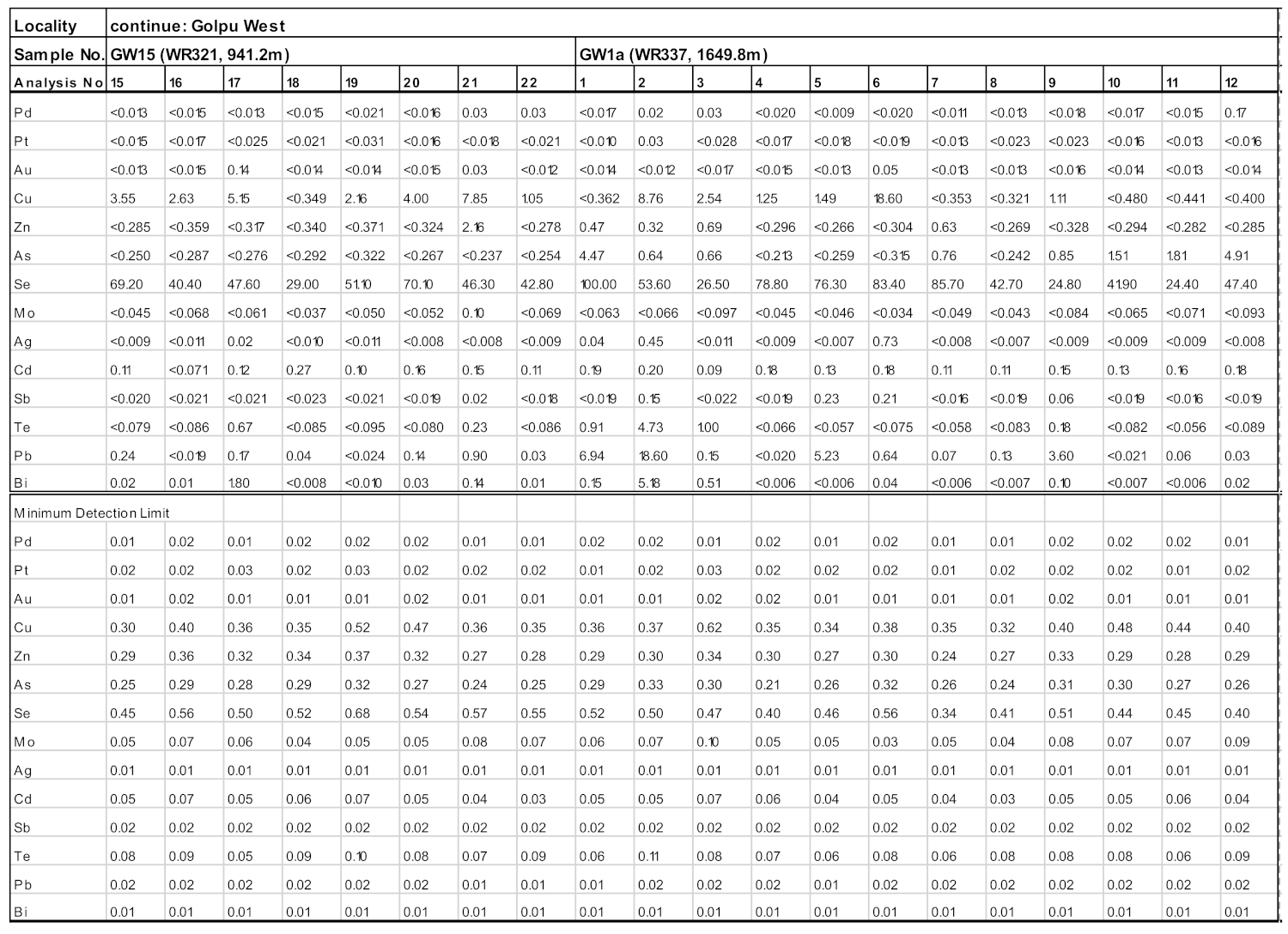
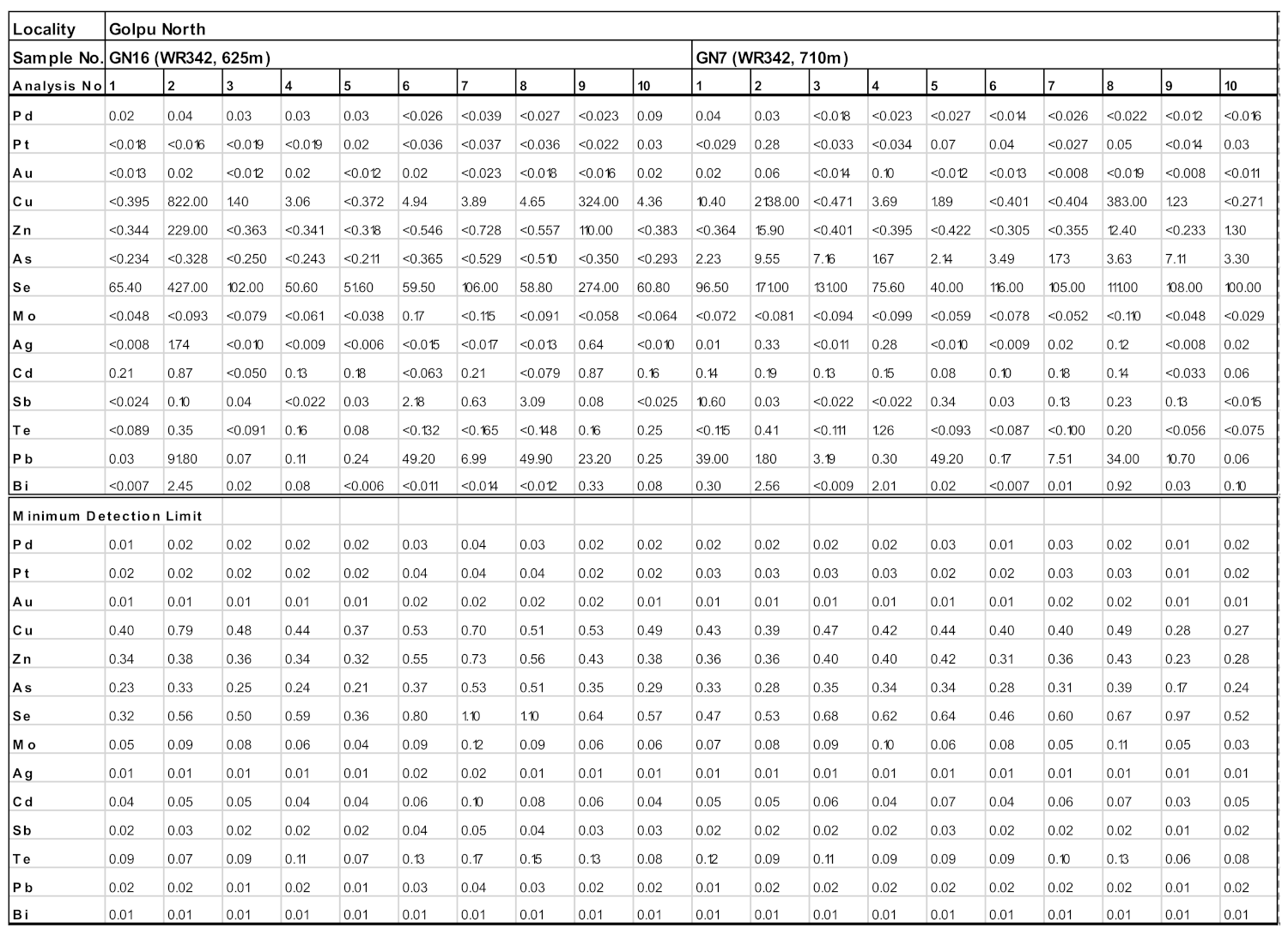
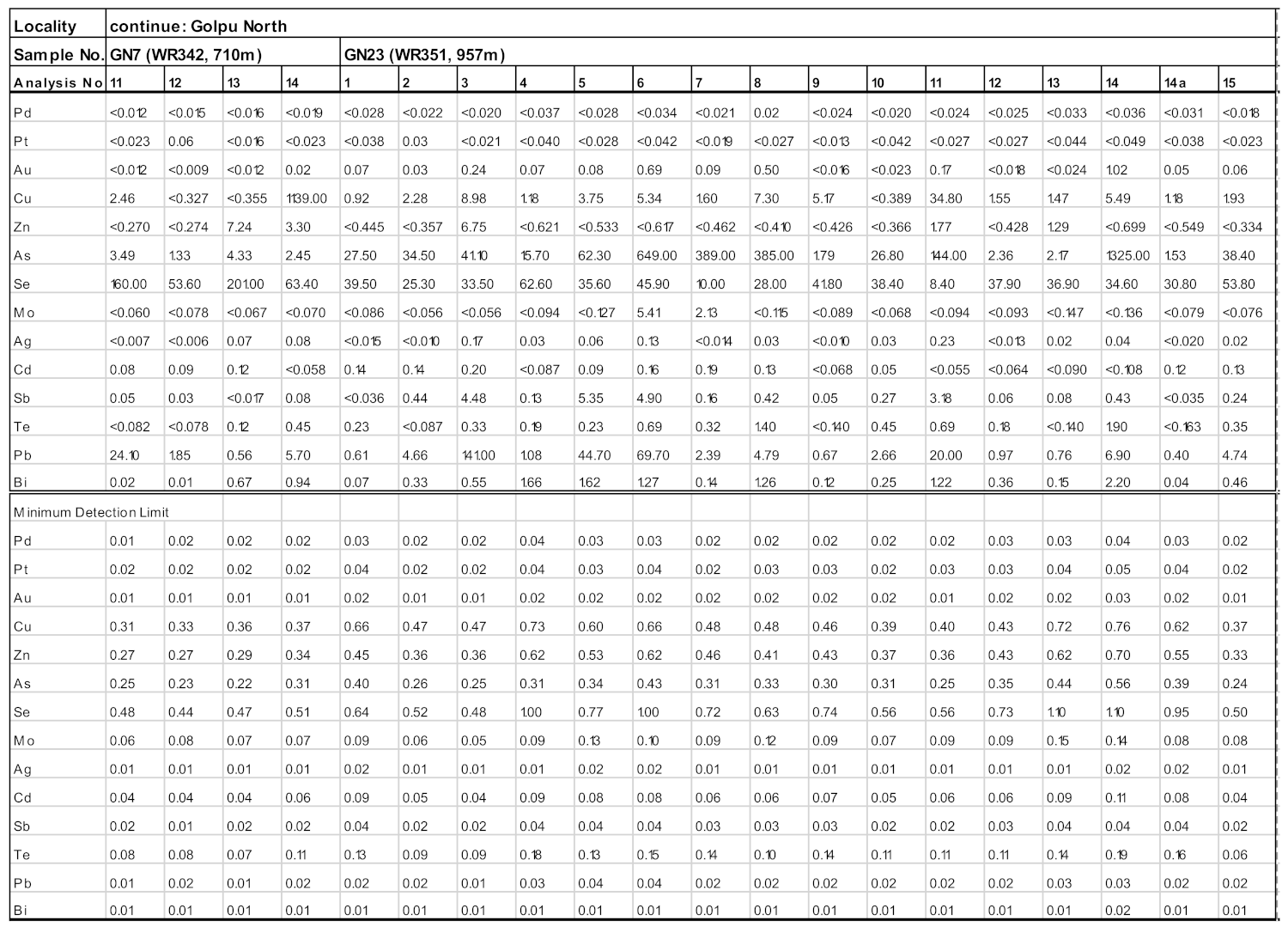
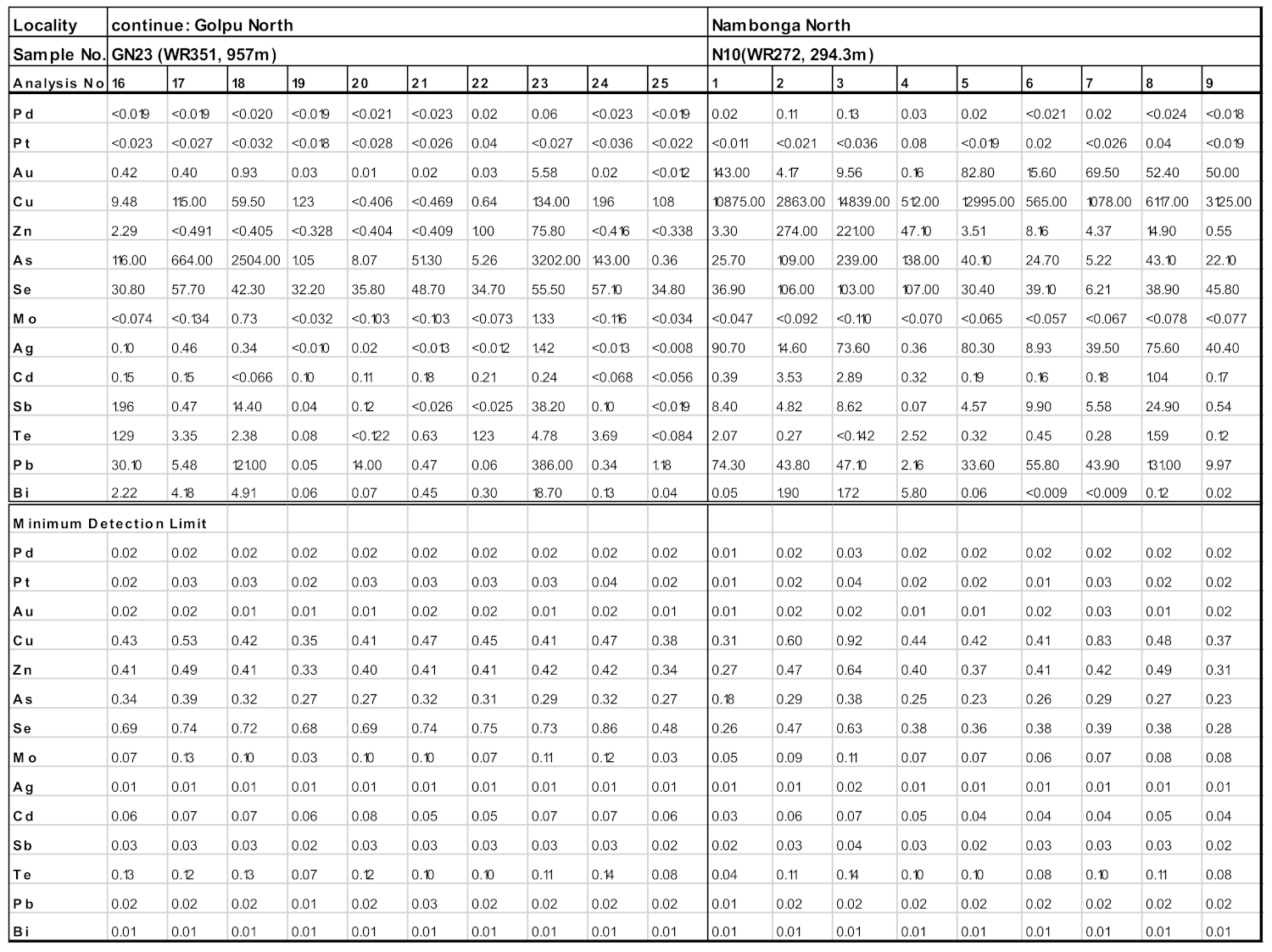
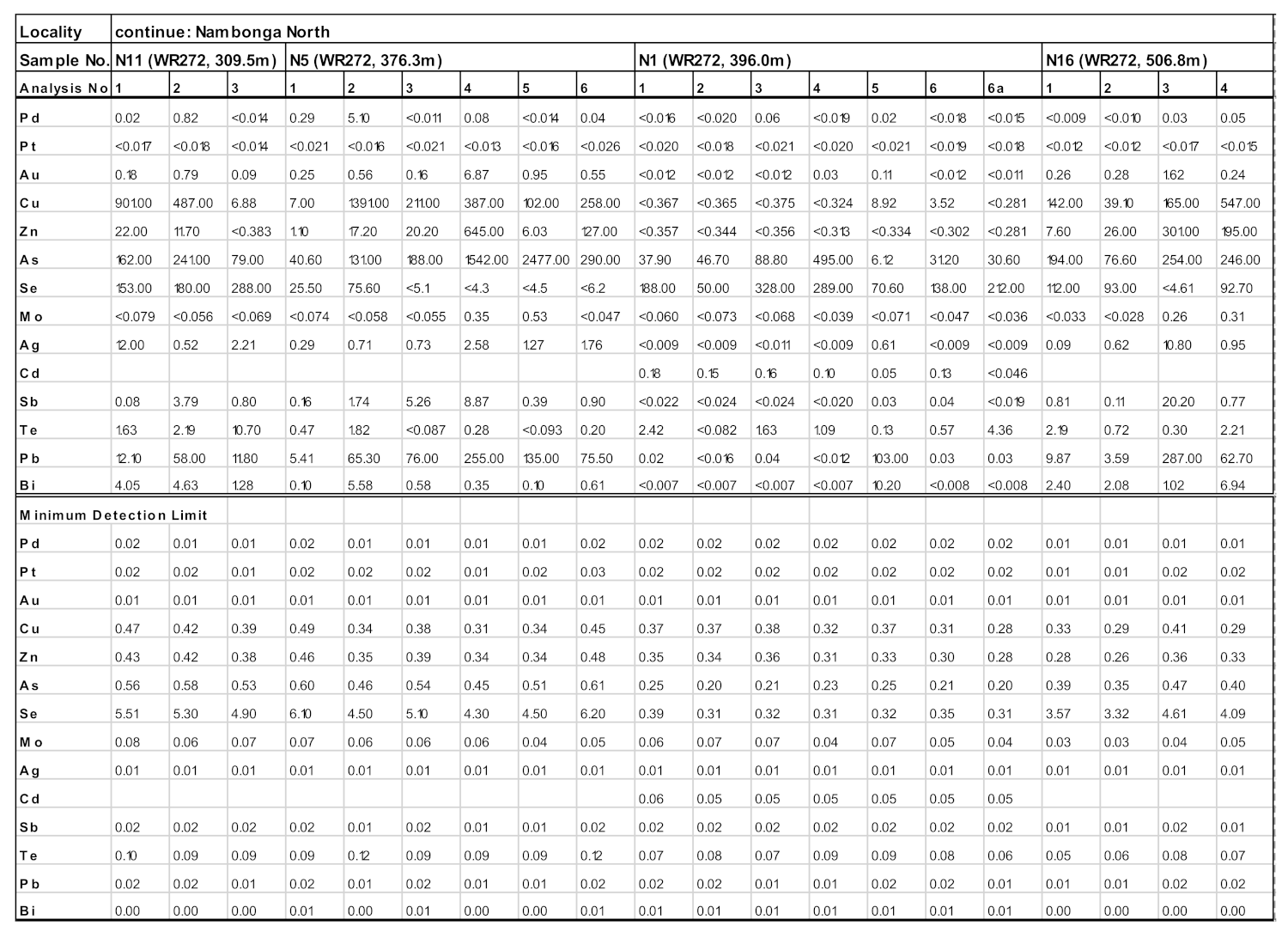
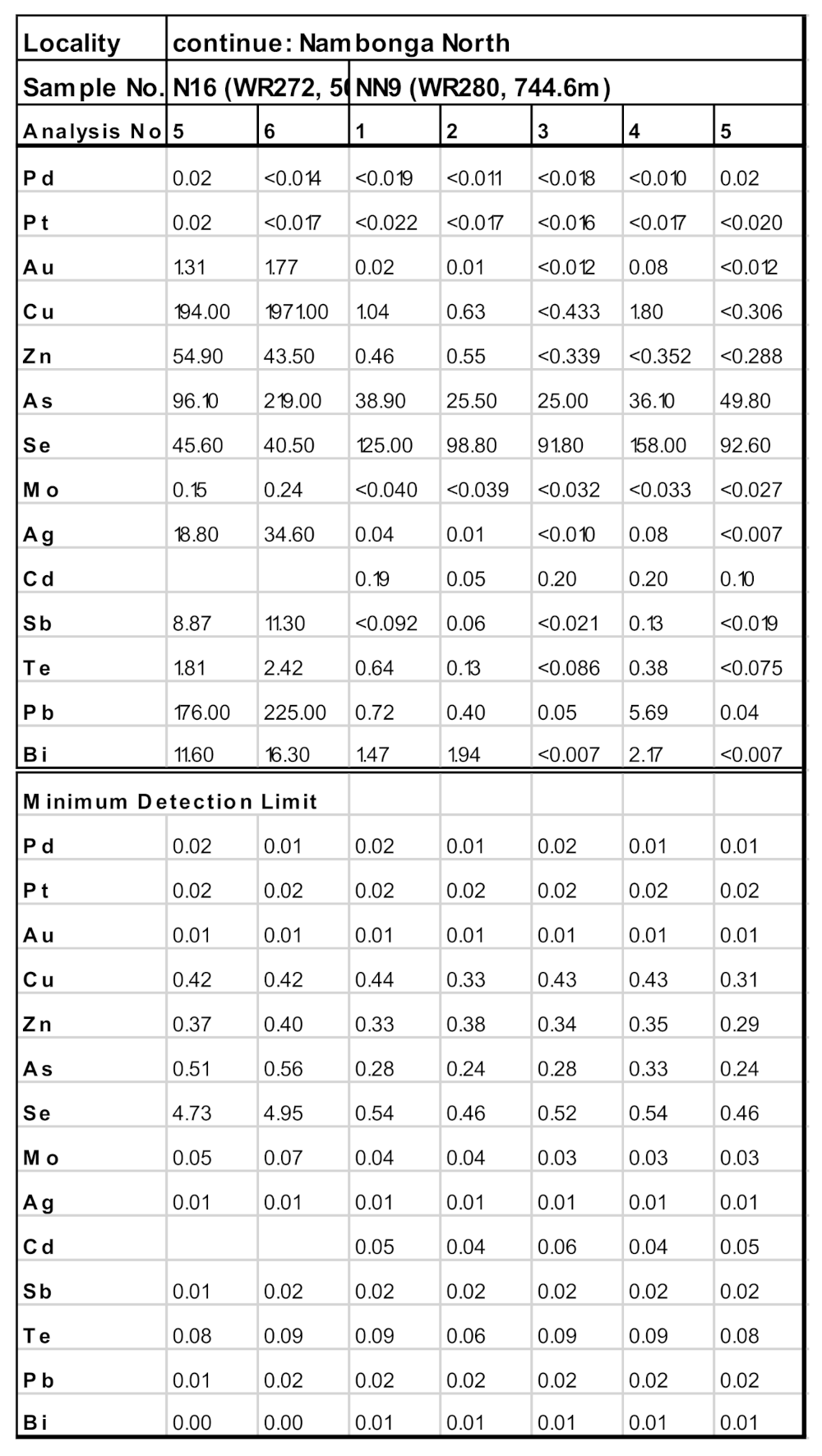
Appendix B. LA-ICPMS Results from the Chalcopyrite Samples from the Golpu and Nambonga North Porphyry Deposits, WGMD, PNG
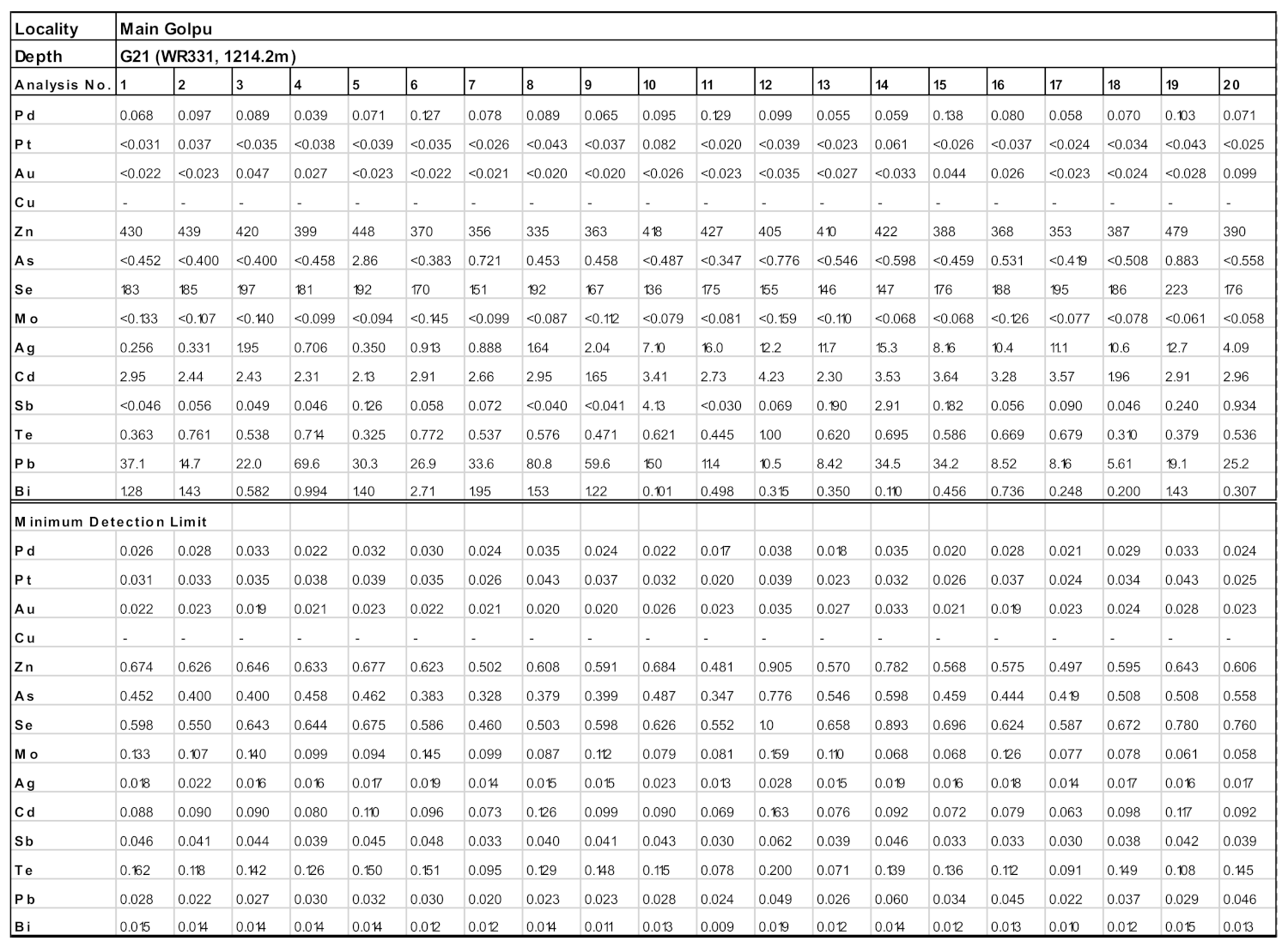

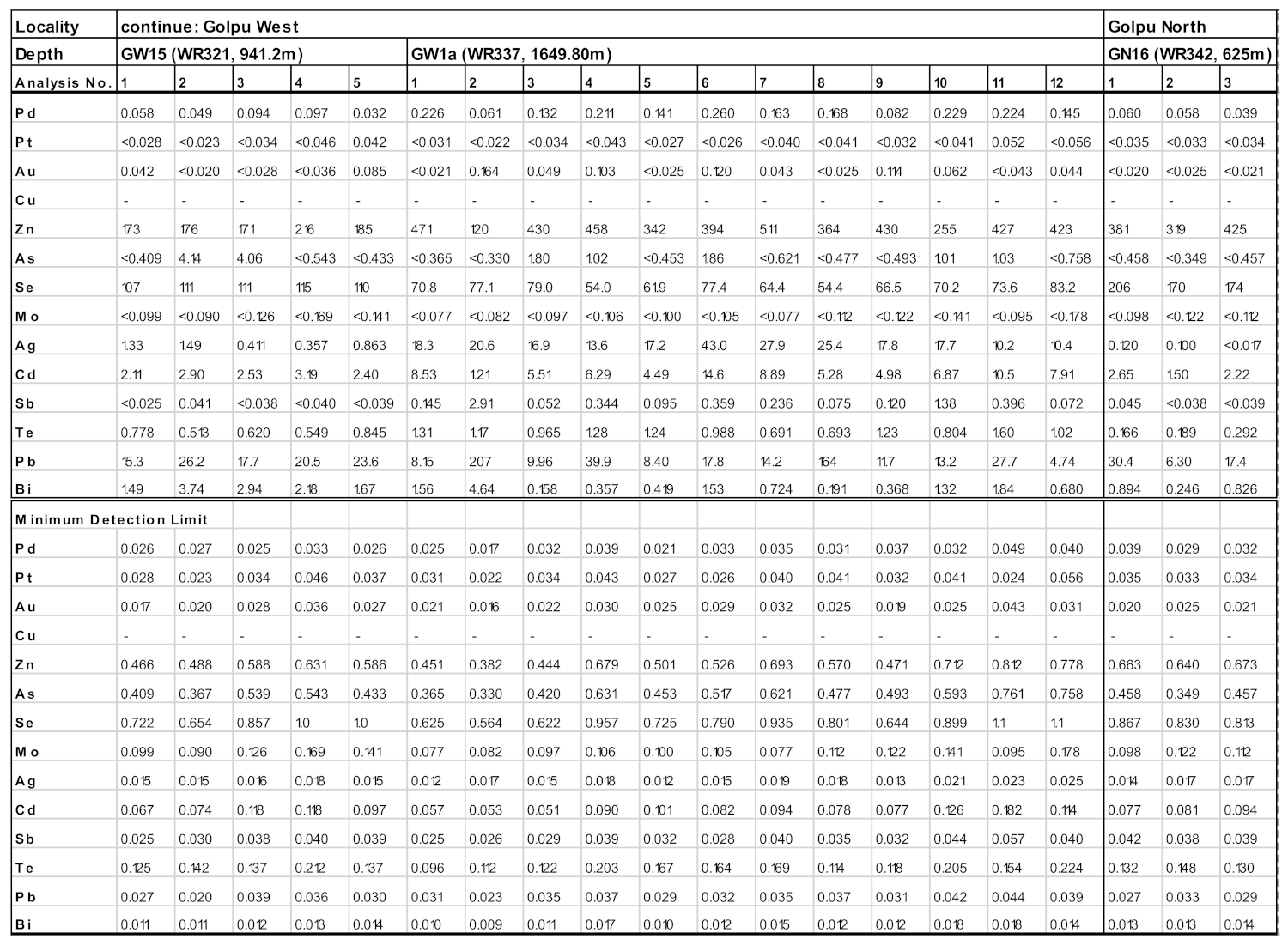
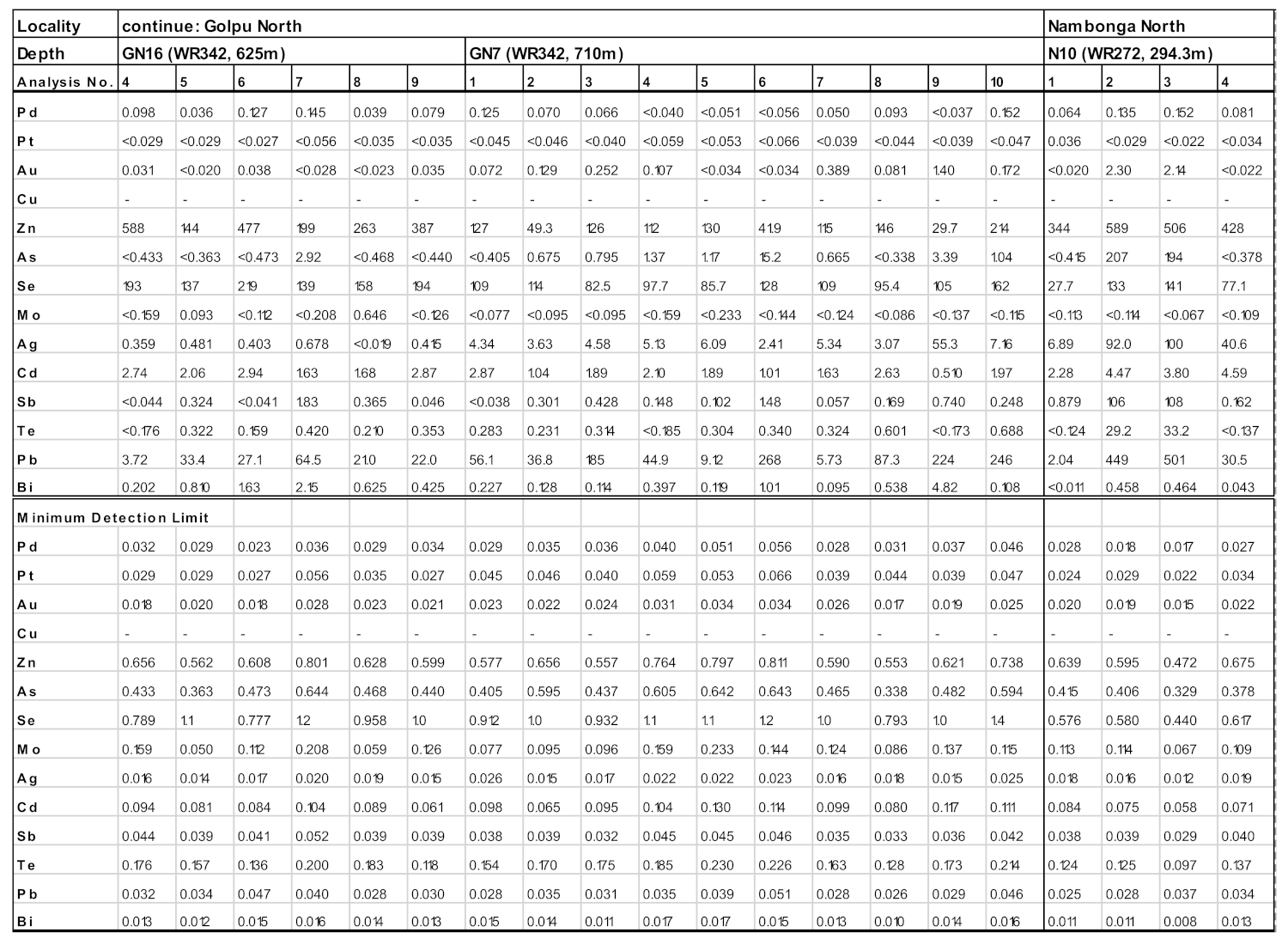

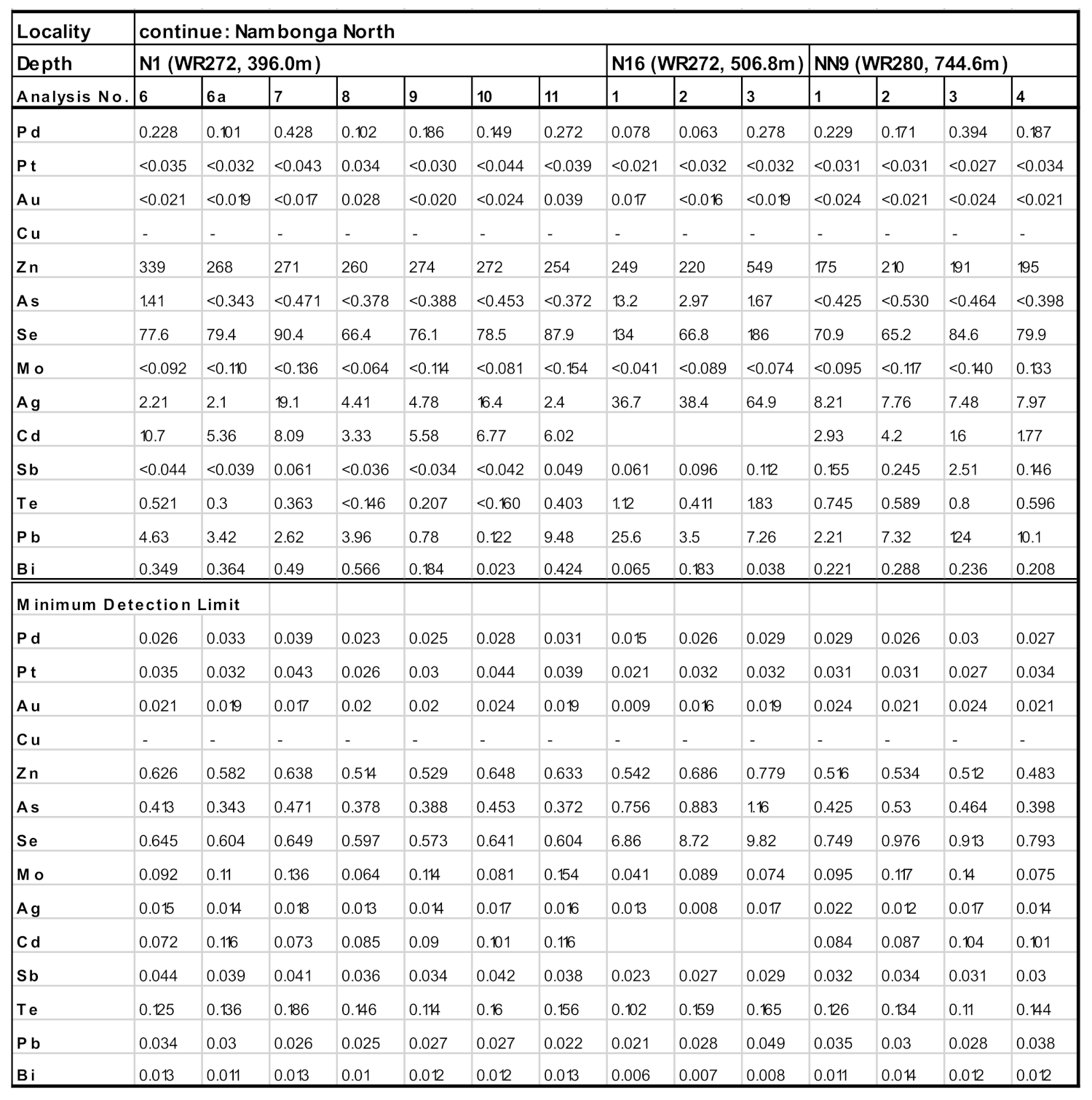
References
- Corbett, G.J. Regional structural control of selected Cu/Au occurrences. In Proceedings of the Papua New Guinea Geology, Exploration and Mining Conference, Lae, Papua New Guinea, 19–21 August 1994; Rogerson, R., Ed.; The Australasian Institute of Mining and Metallurgy: Melbourne, Australia, 1994; pp. 57–70. [Google Scholar]
- Corbett, G.J.; Leach, T.M. Southwest Pacific Au-Cu Systems: Structure, Alteration and Mineralization; Special Publication 6; Society of Economic Geologists: Littleton, CO, USA, 1998; Volume 238. [Google Scholar]
- Leach, T.M. Evolution of selected porphyry Cu-Au systems in the southwest Pacific region and its relevance to exploration Environments. In Proceedings of the Pacrim’99, Bali, Indonesia, 10–13 October 1999; The Australasian Institute of Mining and Metallurgy: Melbourne, Australia, 1999; pp. 211–225. [Google Scholar]
- Klootwijk, C.; Giddings, J.; Pigram, C.; Loxton, C.; Davies, H.L.; Rogerson, R.; Falvey, D. Papua New Guinea Highlands: Plaeomagnetic constraints on terrane tectonics. Tectonophysics 2003, 362, 239–272. [Google Scholar] [CrossRef]
- Davies, H.L. The Geology of New Guinea—The Cordilleran Margin of the Australian Continent; Episodes; International Union of Geological Sciences: Chuncheon, Korea, 2012; Volume 35, pp. 87–102. [Google Scholar]
- Holm, R.J.; Rosenbaum, G.; Richards, S.W. Post 8 Ma reconstruction of Papua New Guinea and Solomon Islands: Microplate tectonics in a convergent plate boundary setting. Earth Sci. Rev. 2016, 156, 66–81. [Google Scholar] [CrossRef] [Green Version]
- Holm, R.J.; Tapster, S.; Jelsma, H.A.; Rosenbaum, G.; Mark, D.F. Tectonic evolution and Cu-Au metallogenesis of the Papua New Guinea and Solomon Islands region. Ore Geol. Rev. 2019, 104, 208–226. [Google Scholar] [CrossRef] [Green Version]
- Newcrest Mining Limited. Wafi-Golpu Project, Morobe Province, Papua New Guinea, NI-43 101 Technical Report; Newcrest Mining Limited: Melbourne, Australia, 2020; Volume 345. [Google Scholar]
- Dow, D.B. A Geological Synthesis of Papua New Guinea; Bulletin 201; Australian Bureau of Mineral Resources, Geology and Geophysics: Canberra, Australia, 1977. [Google Scholar]
- Pigram, C.J.; Davies, H.L. Terranes and the accretion history of the New Guinea orogen. BMR J. Aust. Geol. Geophys. 1987, 10, 193–212. [Google Scholar]
- Rogerson, R.; Hilyard, D.; Francis, G.; Finlayson, E. The foreland thrust belt of Papua New Guinea. In Proceedings of the Pacific Rim Congress 87, Gold Coast, Australia, 26–29 August 1987; The Australasian Institute of Mining and Metallurgy: Parkville, MO, USA, 1987; pp. 579–583. [Google Scholar]
- Hill, K.C.; Hall, R. Mesozoic-Cainozoic Evolution of Australia’s New Guinea Margin in A West Pacific Context; Special Publication; Geological Society of Australia: New South Wales, Australia, 2003; Volume 22, pp. 259–283. [Google Scholar]
- Quarles van Ufford, A.; Corbett, M. Cainnozoic tectonics of New Guinea. AAPG Bull. 2005, 89, 119–140. [Google Scholar] [CrossRef]
- Holm, R.J.; Spandler, C.; Richards, S.W. Continental collision, orogenesis and arc magmatism of the Miocene Maramuni arc, Papua New Guinea. Gondwana Res. 2015, 28, 1117–1136. [Google Scholar] [CrossRef]
- Hall, R. Cenozoic geological and plate tectonic evolution of South-east Asia and the South-west Pacific: Computer-based reconstructions, model and animations. J. Asian Earth Sci. 2002, 20, 353–431. [Google Scholar] [CrossRef]
- Sheppard, S.; Cranfield, L. Geological Framework and Mineralisation of Papua New Guinea: An Update; Geological Survey Division, Mineral Resources Authority: Port Moresby, Papua New Guinea, 2012; pp. 2–3. [Google Scholar]
- Holm, R.; Gold, D.; White, L.; Webb, M.; Mahoney, L.; McLaren, S.; Heilbronn, K.; Oesterle, J.; Mizera, M.; Saroa, D.; et al. Provenance and Tectonics of the Allochthonous New Guinea Terranes: Implications for the Formation and Evolution of Regional Basins. In Proceedings of the 2020 1st AAPG/EAGE PNG Geoscience Conference and Exhibition, PNG’s Oil and Gas Industry Maturing Through Exploration, Development and Production, Port Moresby, Papua New Guinea, 25–27 February 2020. [Google Scholar]
- Leach, T.M.; Erceg, M.M. The Wafi River high sulphur epithermal Au deposit, Papua New Guinea. In Proceedings of the Pacific Rim Congress 90, Gold Coast, QLD, Australia, 6–12 May 1990; The Australasian Institute of Mining and Metallurgy: Parkville, MO, USA, 1990; pp. 451–456. [Google Scholar]
- Funnell, F.R. Wafi River Au prospect. In Geology of the Mineral Deposits of Australia and Papua New Guinea 1990; The Australian Institute of Mining and Metallurgy: Melbourne, Australia, 1990; pp. 1731–1733. [Google Scholar]
- Tau-Loi, D.; Andrew, R.L. Wafi Cu-Au deposit. In Geology of Australian and Papua New Guinean Mineral Deposits; Berkman, D.A., Mackenzie, D.H., Eds.; The Australasian Institute of Mining and Metallurgy: Melbourne, Australia, 1998; Volume 22, pp. 827–832. [Google Scholar]
- Rinne, M.L.; Cooke, D.R.; Harris, A.C.; Finn, D.J.; Allen, C.M.; Heizler, M.T.; Creaser, R.A. Geology and Geochronology of the Golpu porphyry and Wafi epithermal deposit, Morobe Province, Papua New Guinea. Econ. Geol. 2018, 113, 271–294. [Google Scholar] [CrossRef]
- Wells, J.D.; Mullens, T.E. Gold-bearing arsenian pyrite determined by microprobe analysis, Cortez and Carlin Au mines, Nevada. Econ. Geol. 1973, 68, 187–201. [Google Scholar] [CrossRef]
- Fleet, M.E.; Chryssoulis, S.L.; MacLean, P.J.; Davidson, R.; Weisener, C.G. Arsenian pyrite from Au deposits: Au and As distribution investigated by SIMS and EMP and colour staining and surface oxidation by XPS and LIMS. Can. Mineral. 1993, 31, 1–17. [Google Scholar]
- Mumin, A.H.; Fleet, M.E.; Chryssoulis, S.L. Gold mineralisation in As-rich mesothermal Au ores of the Bogosu-Prestea mining district of the Ashanti Gold Belt, Ghana: Remobilisation of “invisible” Au. Miner. Depos. 1994, 29, 445–460. [Google Scholar] [CrossRef]
- Fleet, M.E.; Mumin, A.H. Gold-bearing arsenian pyrite and marcasite and arsenopyrite from Carlin Trend Au deposits and laboratory synthesis. Am. Mineral. 1997, 82, 182–193. [Google Scholar] [CrossRef]
- Shi Jian, B.; Jian Wei, L.; Mei Fu, Z.; Zhan Ke, L. Gold distribution in As-deficient pyrite and telluride mineralogy of the Yangzhaiyu Au deposit, Xiaoqinling district, southern North China craton. Miner. Depos. 2011, 46, 925–941. [Google Scholar]
- Reich, M.; Deditius, A.; Chryssoulis, S.; Li, J.-W.; Ma, C.-Q.; Parada, M.A.; Barra, F.; Mittermayr, F. Pyrite as a record of hydrothermal fluid evolution in a porphyry copper system: A SIMS/EMPA trace element study. Geochim. Cosmochim. Acta 2013, 104, 42–62. [Google Scholar] [CrossRef]
- Weissmann, A. Petrochemistry, Sulfur Isotope and Fluid Inclusion Study on Some Porphyry Cu Deposits on the Island of New Guinea. Master’s Thesis, Clausthal University of Technology, Clausthal-Zellerfeld, Germany, 2012. [Google Scholar]
- Gustafson, L.B.; Hunt, J.P. The porphyry copper deposit at El Salvador, Chile. Econ. Geol. 1975, 70, 857–912. [Google Scholar] [CrossRef]
- Clark, A.H. Are Outsize Porphyry Copper Deposits Either Anatomically or Environmentally Distinctive? Special Publication 2; Society of Economic Geologists: Littleton, CO, USA, 1993; pp. 213–283. [Google Scholar]
- Williamson, A.; Hancock, G. (Eds.) The Geology and Mineral. Potential of Papua New Guinea: Papua New Guinea Department of Mining; Papua New Guinea Department of Mining: Port Moresby, Papua New Guinea, 2005; Volume 152. [Google Scholar]
- Lunge, M. A Mineralogical, Geochemical and Geochronological Study of the Golpu and Nambonga North Porphyry Cu-Au Systems, Wafi-Golpu Mineral District, Papua New Guinea. Master’s Thesis, University of Papua New Guinea, Port Moresby, Papua New Guinea, 2013. [Google Scholar]
- Sillitoe, R.H. Porphyry copper systems. Econ. Geol. 2010, 105, 3–41. [Google Scholar] [CrossRef] [Green Version]
- Corbett, G.J. Geology and Mineral Potential of Papua New Guinea; Papua New Guinea Department of Mining: Port Moresby, Papua New Guinea, 2005; Volume 152. [Google Scholar]
- Arribas, A., Jr.; Hendequist, J.W.; Itaya, T.; Okada, T.; Concepción, R.A.; Garcia, J.S., Jr. Contemporaneous formation of adjacent porphyry and epithermal Cu-Au deposits over 300 ka in northern Luzon, Philippines. Geology 1995, 23, 337–340. [Google Scholar] [CrossRef]
- Espi, J.O. Nena High Sulfidation-Type Deposit, Frieda River, Papua New Guinea: Host-Rock Types, Hydrothermal Alteration and Copper-gold Mineralization. In Pacrim Congress 1999, Bali Indonesia; Weber, G., Ed.; Australasian Institute of Mining and Metallurgy (Melbourne): Melbourne, Australia, 1999; pp. 473–481. [Google Scholar]
- Hedenquist, J.W.; Matsuhisa, Y.; Izawa, E.; White, N.C.; Giggenbach, W.; Oaki, M. Geology, geochemistry and origin of high sulfidation Cu-Au mineralization in the Nansatsu district, Japan. Econ. Geol. 1994, 89, 1–30. [Google Scholar] [CrossRef]
- Mavrogenes, J.A.; Berry, A.J.; Newville, M.; Tutton, S.R. Copper speciation in vapor-phase inclusions from the Mole Granite, Australia. Am. Mineral. 2002, 87, 1360–1364. [Google Scholar] [CrossRef]
- Gammons, C.H.; Williams-Jones, A.E. Chemical mobility of gold in the porphyry-epithermal environment. Econ. Geol. 1997, 92, 45–59. [Google Scholar] [CrossRef]
- Erceg, M.M.; Craighead, G.A.; Halfpenny, R.; Lewis, P.J. The exploration history, geology and metallurgy of a high sulphidation epithermal Au deposit at Wafi River, Papua New Guinea. In Proceedings of the Geology, Exploration and Mining Conference, Rabaul, Papua New Guine, 7–9 November 1991; Rogerson, R., Ed.; The Australasian Institute of Mining and Metallurgy: Parkville, MO, USA; pp. 58–65. [Google Scholar]


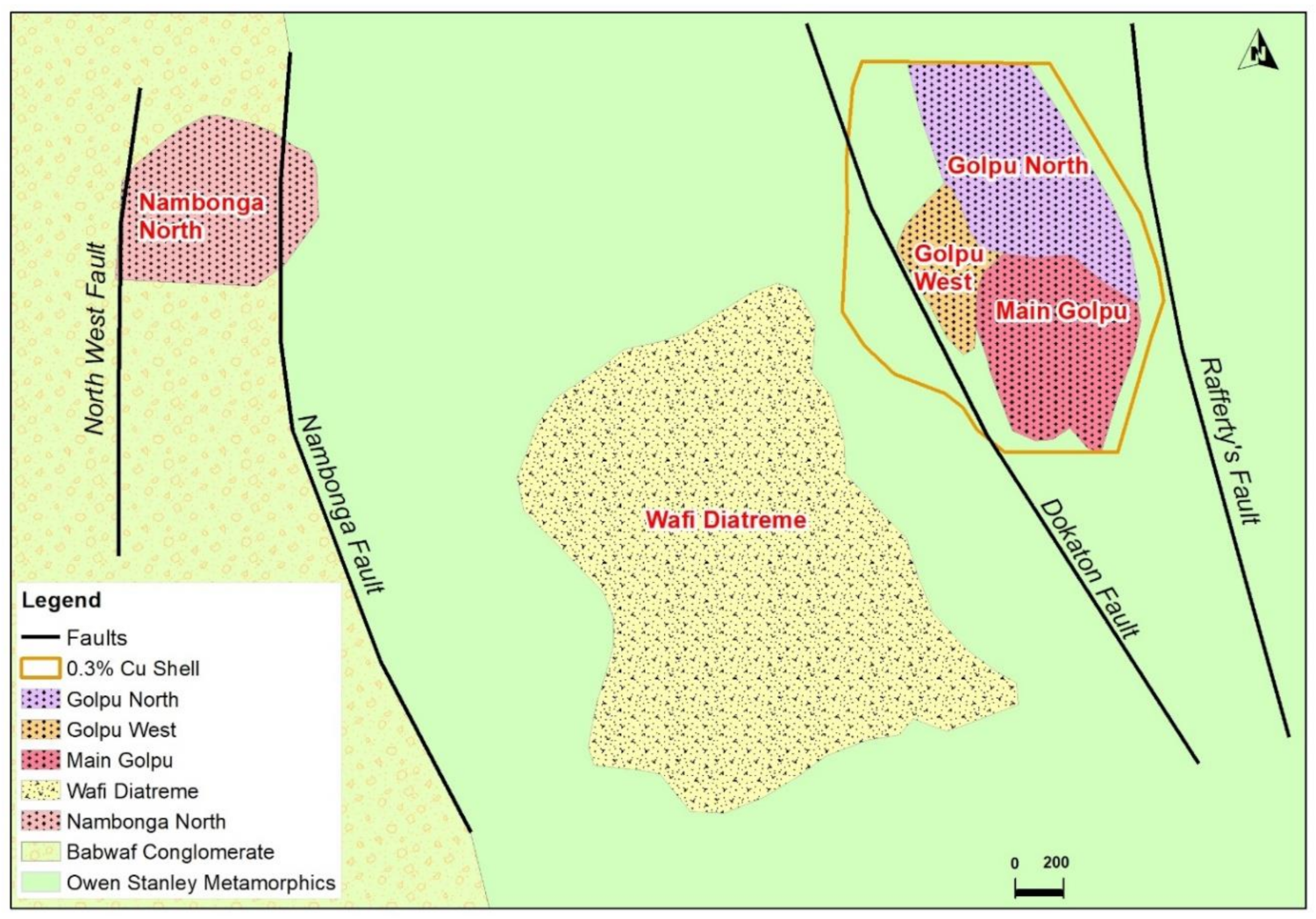
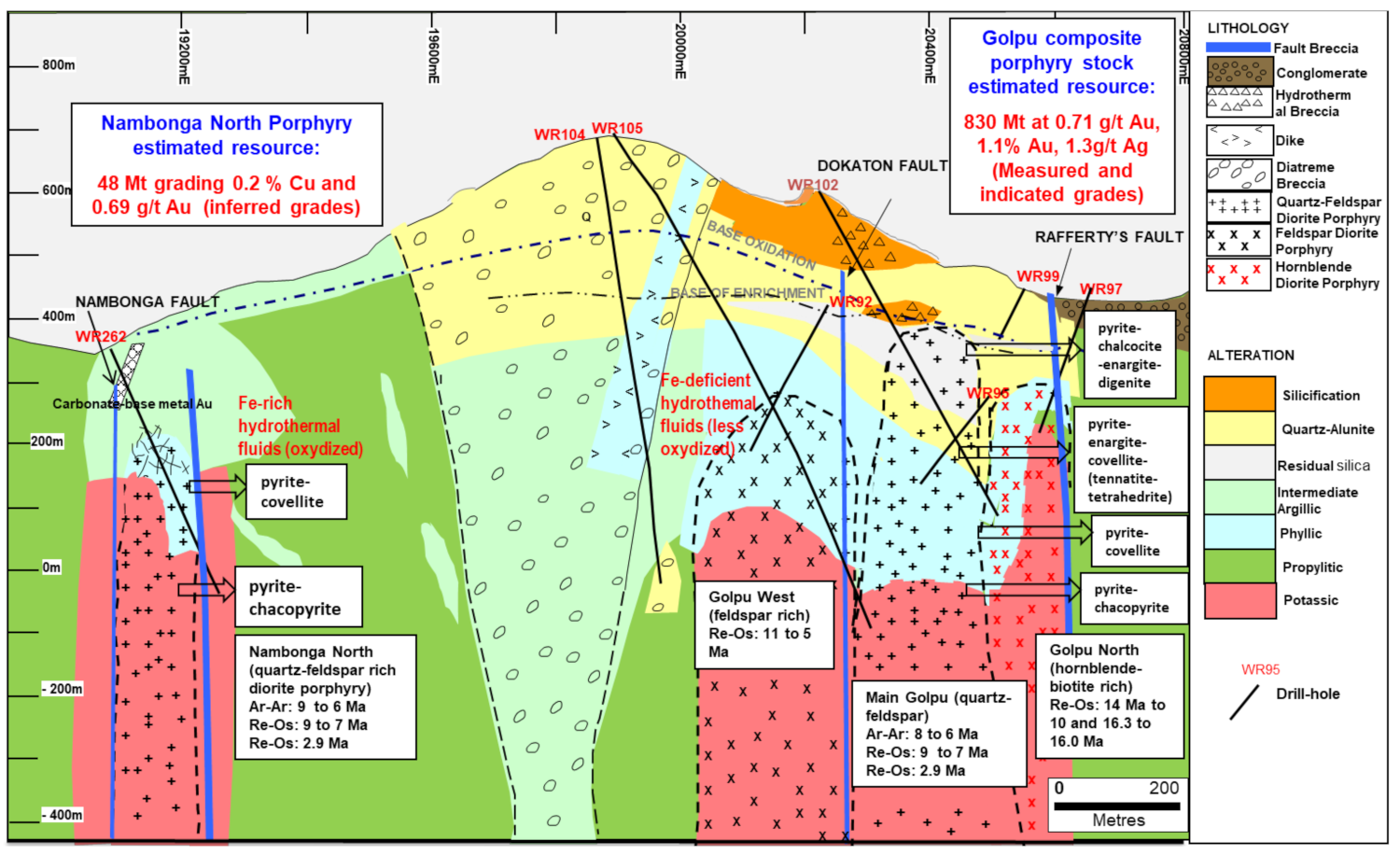
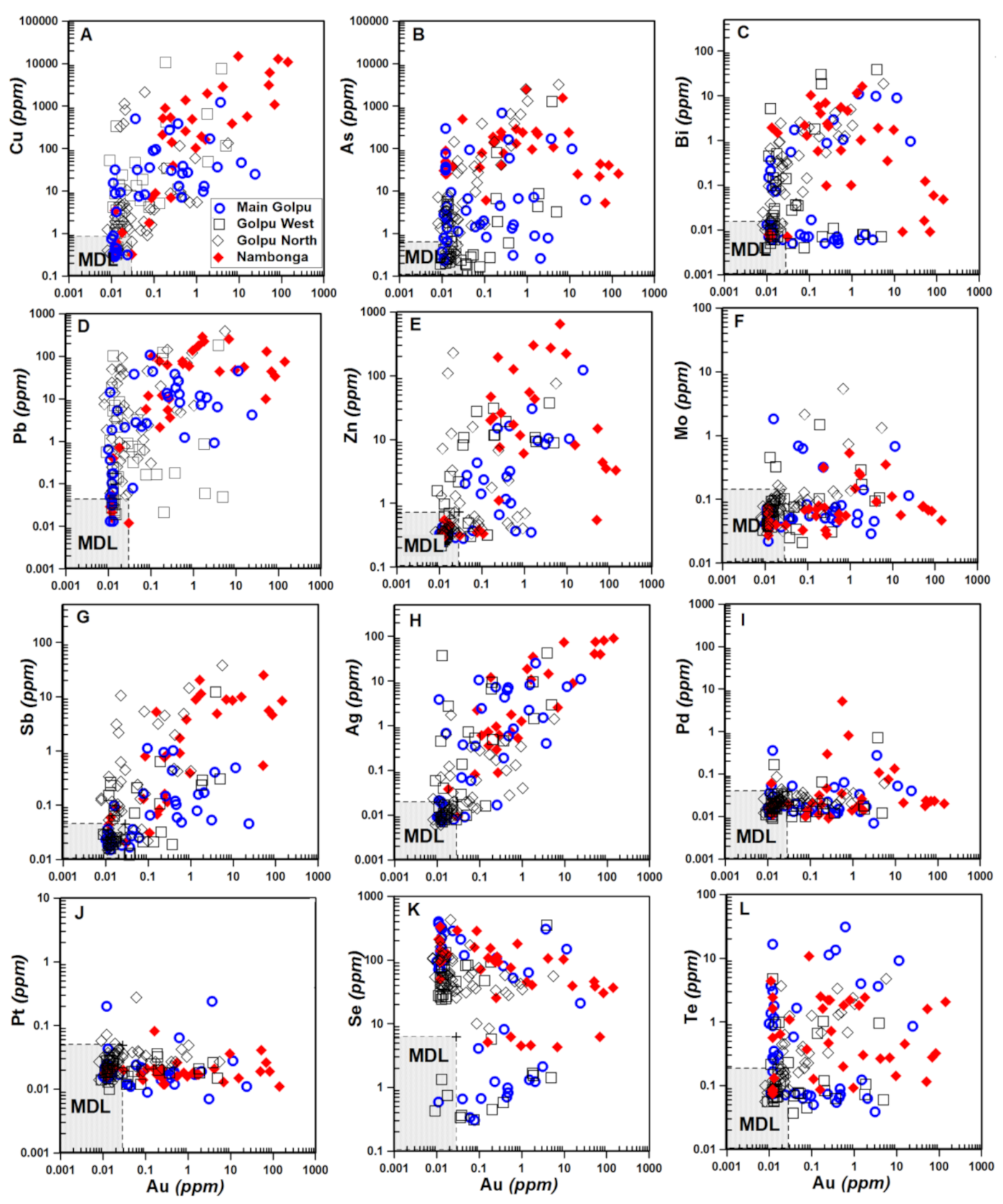
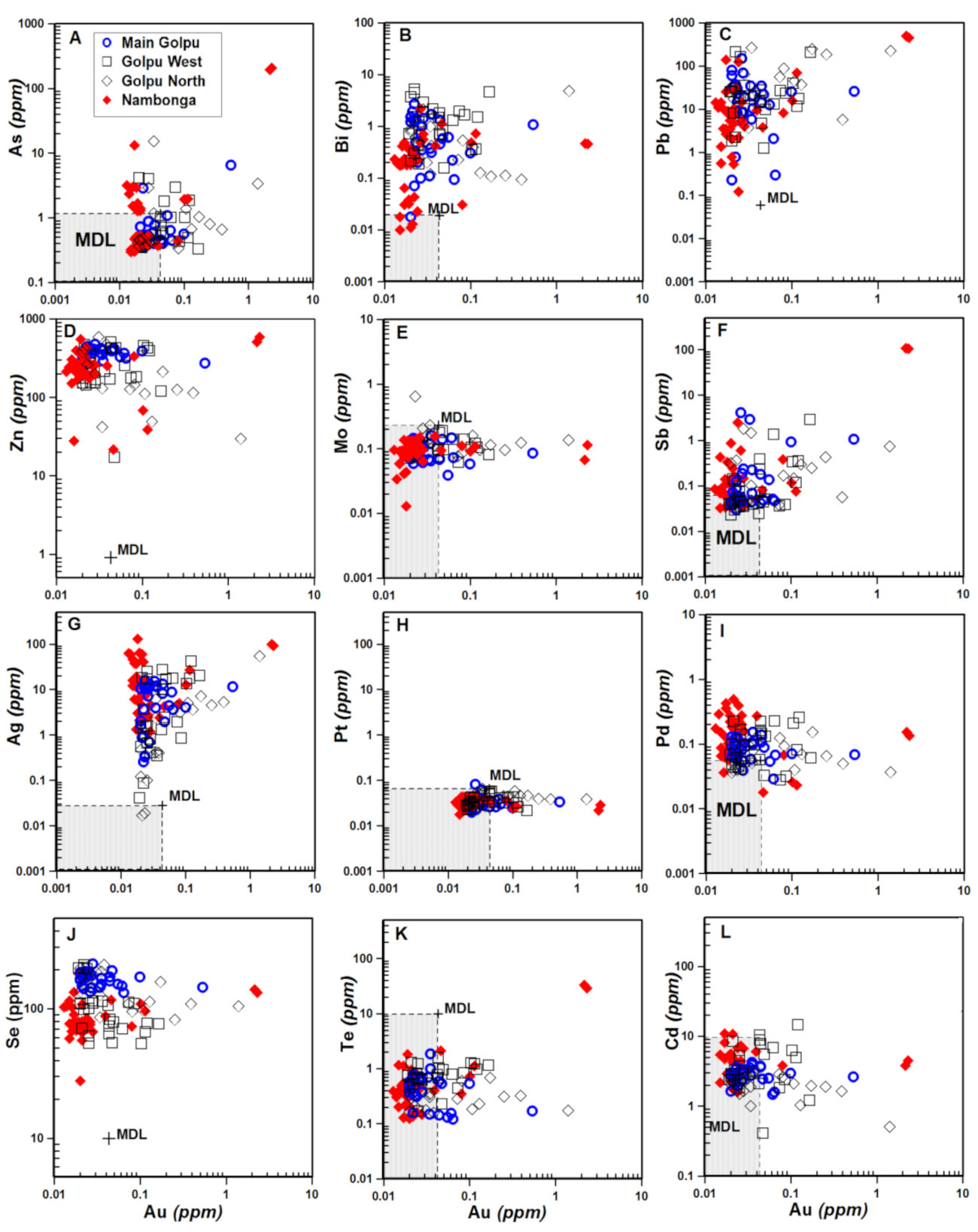
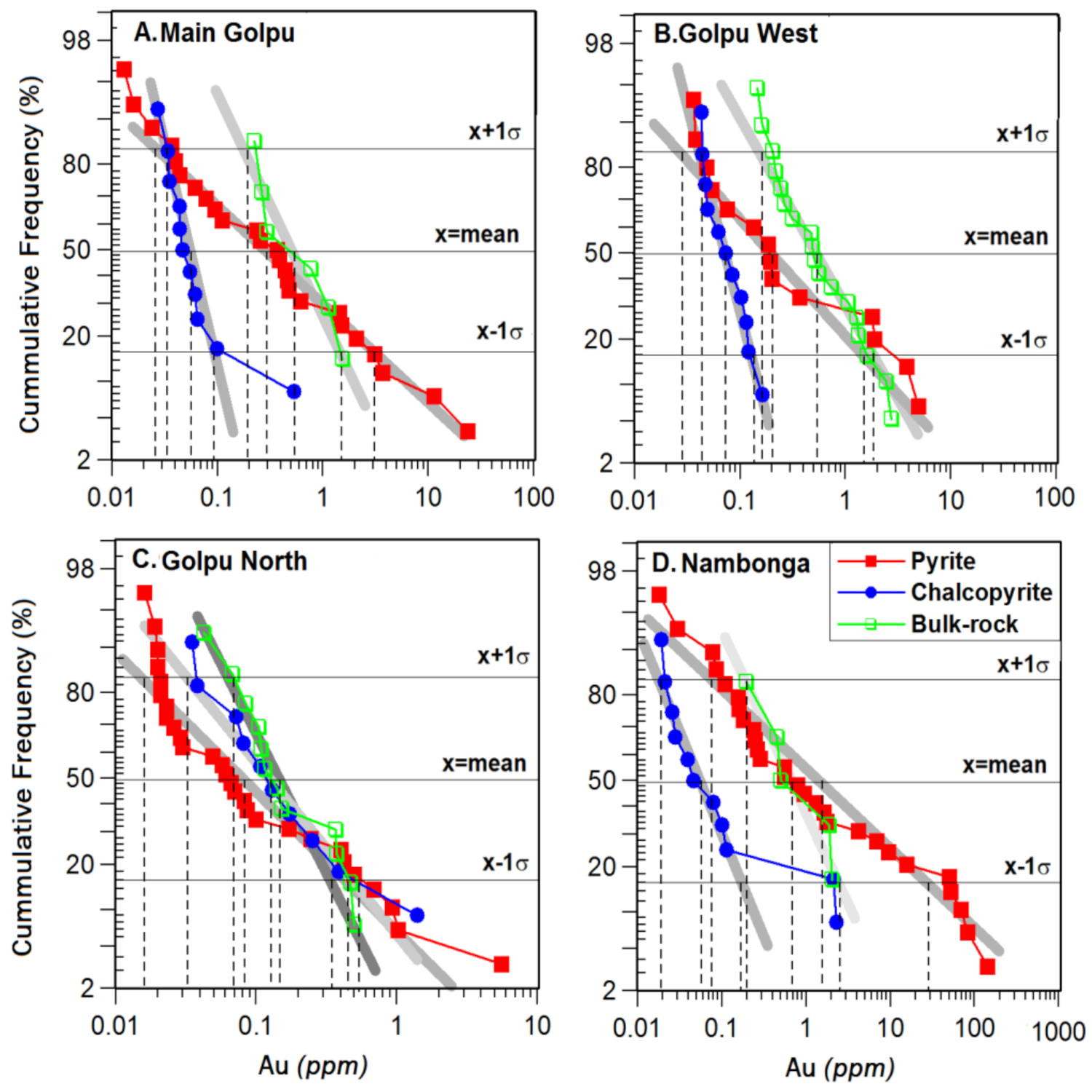

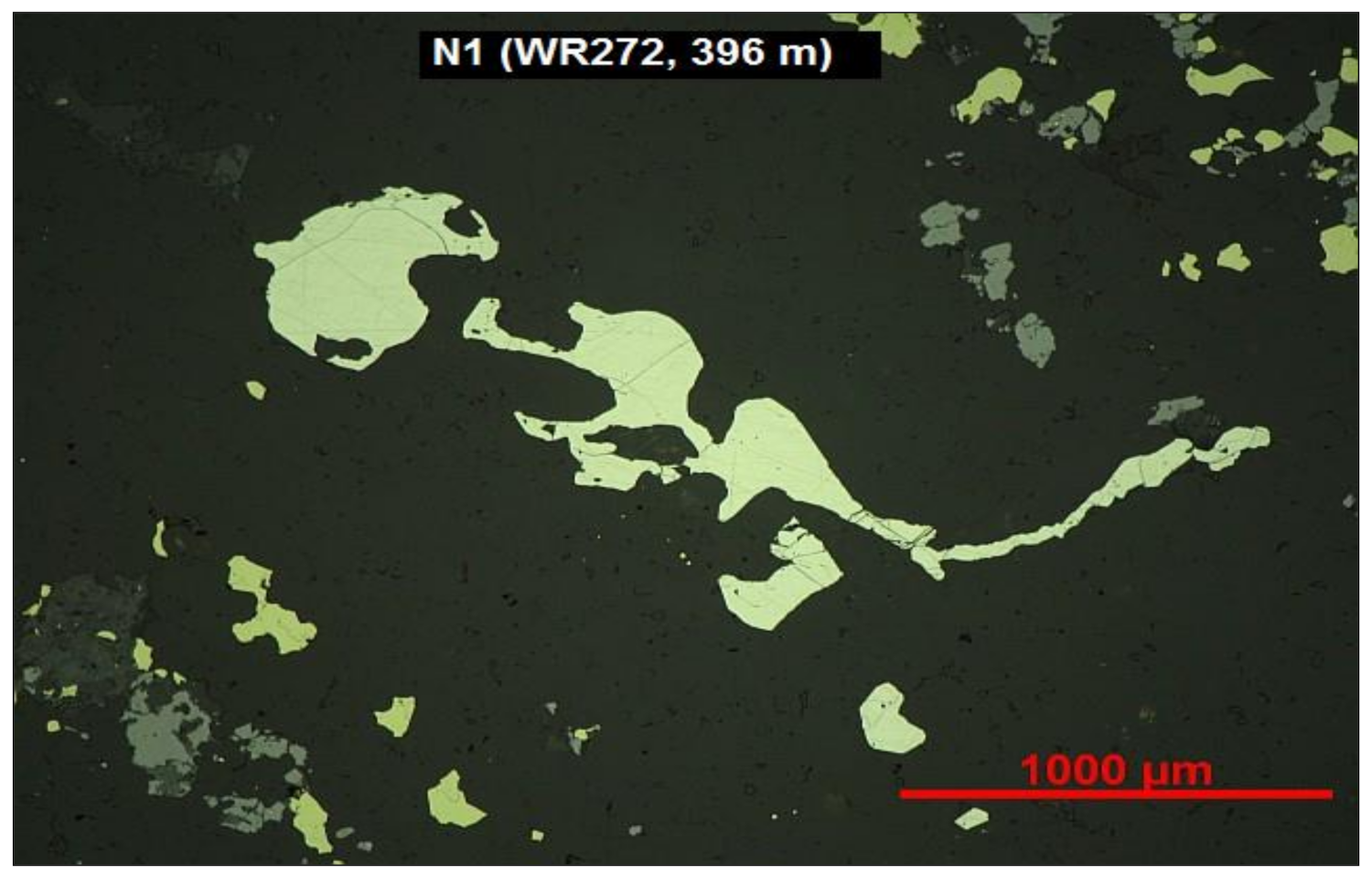


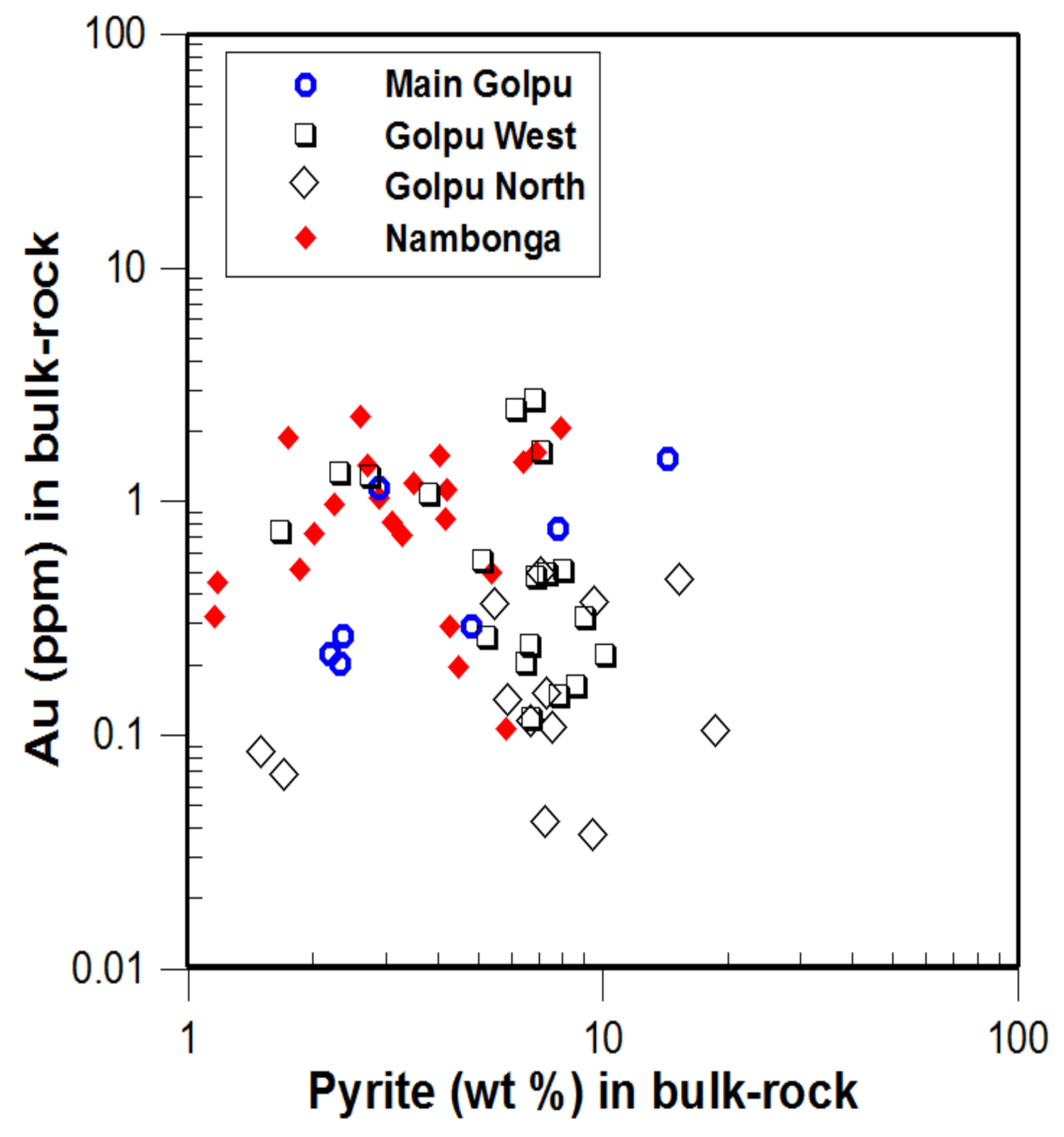
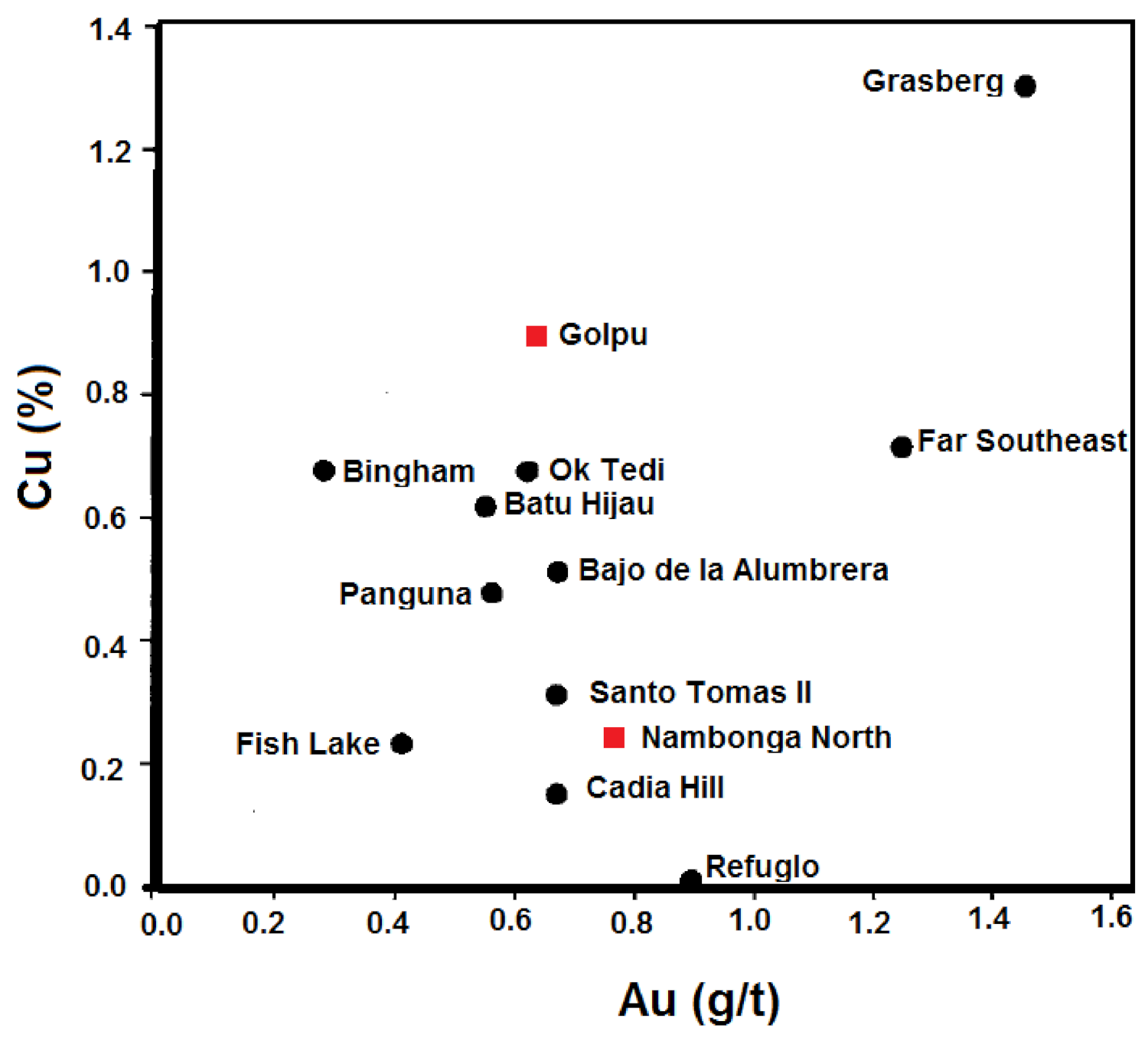
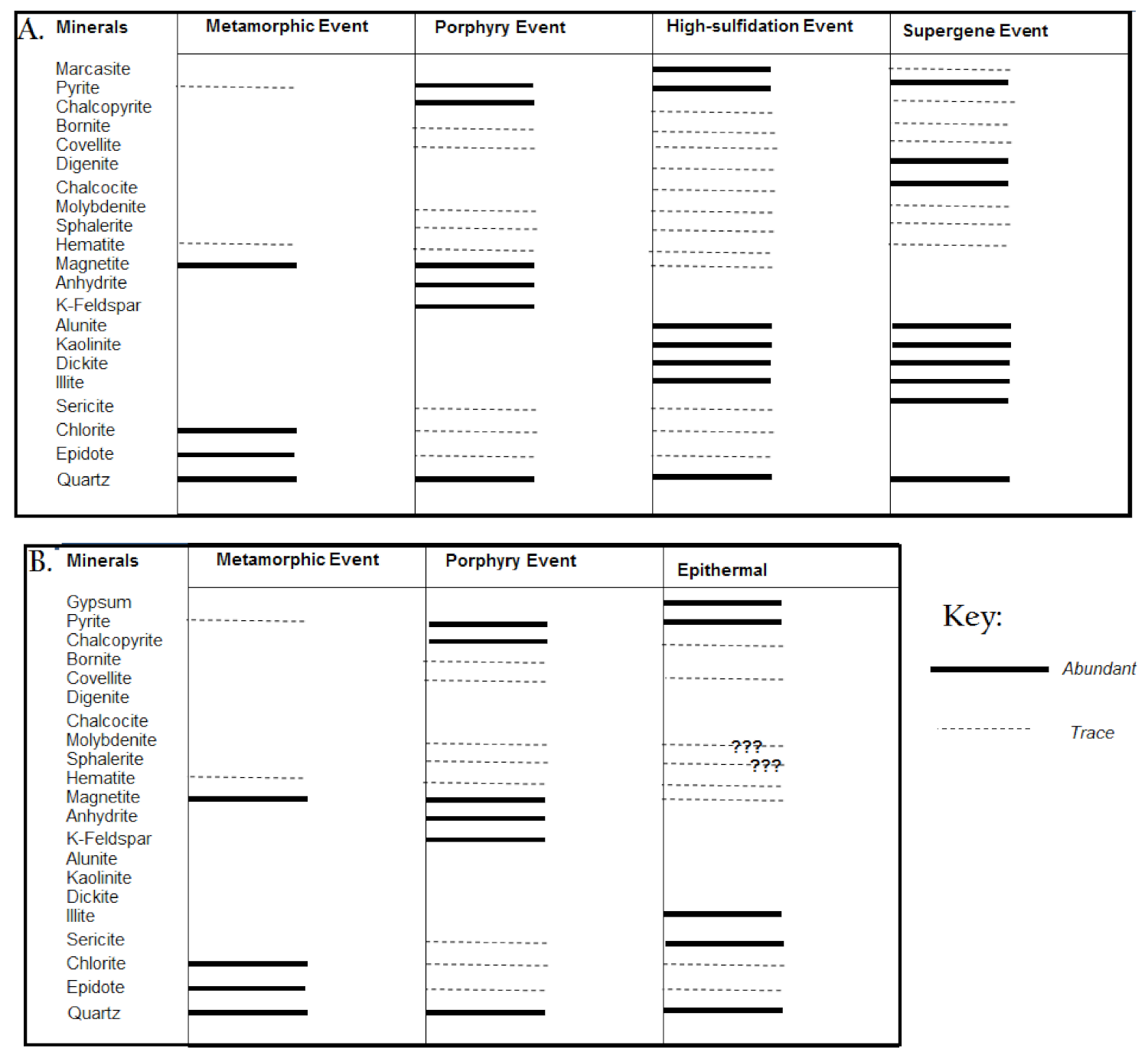
Publisher’s Note: MDPI stays neutral with regard to jurisdictional claims in published maps and institutional affiliations. |
© 2021 by the authors. Licensee MDPI, Basel, Switzerland. This article is an open access article distributed under the terms and conditions of the Creative Commons Attribution (CC BY) license (https://creativecommons.org/licenses/by/4.0/).
Share and Cite
Lunge, M.; Espi, J.O. Trace Element Geochemistry of Chalcopyrites and Pyrites from Golpu and Nambonga North Porphyry Cu-Au Deposits, Wafi-Golpu Mineral District, Papua New Guinea. Geosciences 2021, 11, 335. https://doi.org/10.3390/geosciences11080335
Lunge M, Espi JO. Trace Element Geochemistry of Chalcopyrites and Pyrites from Golpu and Nambonga North Porphyry Cu-Au Deposits, Wafi-Golpu Mineral District, Papua New Guinea. Geosciences. 2021; 11(8):335. https://doi.org/10.3390/geosciences11080335
Chicago/Turabian StyleLunge, Moira, and Joseph O. Espi. 2021. "Trace Element Geochemistry of Chalcopyrites and Pyrites from Golpu and Nambonga North Porphyry Cu-Au Deposits, Wafi-Golpu Mineral District, Papua New Guinea" Geosciences 11, no. 8: 335. https://doi.org/10.3390/geosciences11080335
APA StyleLunge, M., & Espi, J. O. (2021). Trace Element Geochemistry of Chalcopyrites and Pyrites from Golpu and Nambonga North Porphyry Cu-Au Deposits, Wafi-Golpu Mineral District, Papua New Guinea. Geosciences, 11(8), 335. https://doi.org/10.3390/geosciences11080335




